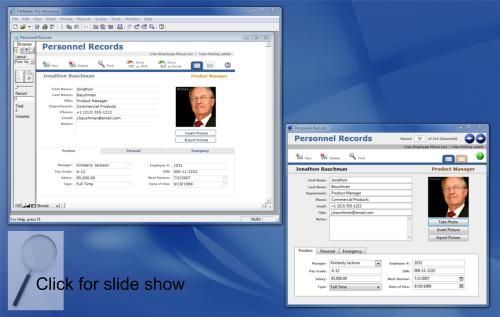Database connectivity is one of Revolution's strongest assets. Built into every copy of Studio is the ability to connect to mySQL, ODBC, PostGre and Valentina database
systems. Revolution Enterprise adds the option to connect to Oracle databases. Building custom front ends to these industrial-strength systems is an increasingly popular application of Revolution. But one of the most popular end-user database applications on Macintosh and Windows platforms is FileMaker Pro. Luckily, this platform is accessible to Revolution as well.
Why Use Revolution with FileMaker?
Many FileMaker users will point out that FileMaker Pro already has some built-in sharing features and the ability, with FileMaker Pro Advanced, to create standalone applications for Windows and Macintosh. So how can Revolution add value to a FileMaker-based solution?
Better Lock-Down When deploying a solution, developers often want to be certain they don't have to support or troubleshoot end-user changes to their solutions, such as modified layouts or scripts. Or they simply want to secure their product from unauthorized snooping. Revolution stacks, deployed as password-protected standalone executables, are not modifiable by end users.
Tighter control of the user experience No matter how much work you do to customize the user experience in FileMaker, it's still a FileMaker database. Without buying expensive 3rd party add-on software you can't eliminate many elements of the user interface such as the "Browse/Find/Layout" mode popup menu and various dialogs. By contrast, Revolution gives you full control of the user experience including palette windows, custom window shapes, OS-native controls, buttons that respond to hovering and clicking, dynamic layouts that adjust to user input, and so on.

A full-featured procedural language FileMaker's "ScriptMaker" is easy for novices, but painfully limiting when it comes to sophisticated solutions.
You can't
trigger scripts based on user input, for example. And data entry constraints only apply after a user has typed their data and tried to submit a record. In Revolution a few lines of script attached to a field ensures only numeric values are entered (you could even beep when a user tries to enter a letter or symbol). A common need is to process free-form text such as what is found in email messages or web pages. This can be kludged with ScriptMaker and FileMaker functions, but most developers will find Revolution scripts, with their powerful chunk expressions and regular expressions support to be an easier-to-write and more robust solution.
Full access to system resources and routines Again, expensive plugins are available for reading and writing files, accessing Internet servers, and sending automated emails. But Revolution provides these features "out of the box." You can read information at runtime about the environment a user is running, read and write to the Windows registry, access the clipboard, zip and unzip files, and much more.
Superior standalones There are so many aspects to writing good standalone software, and so many ways Revolution facilitates this, the topic could be a whole article by itself. Both FileMaker Advanced and Revolution enable you to create royalty-free standalone software. But here are some of the advantages of standalones created with Revolution:
- They're smaller, much smaller. A compressed Revolution standalone can weigh in under 700K, quite practical for online distribution. FileMaker's standalone footprint is about 50 MB.
- They work on more platforms. Including Linux and Windows 98se.
- They look and act like true programs. That means custom icons, a single-file distribution (instead a folder with dozens of individual files), and no user interface elements you don't want.
- Reasonable attribution requirements. In addition to having the FileMaker logo all over your icons and windows, FileMaker imposes a large closing splash screen of 2-12 seconds duration that credits and links to FileMaker, and requires a Help/About screen in a specific format with your name and contact information, plus specific text that must be included. The Revolution license simply asks you to put one line, "Portions (c)2000-2008 Runtime Revolution Limited, All Rights Reserved Worldwide" below your own copyright notice.
- Most importantly, FileMaker standalones are not multi-user enabled. You can't connect to FileMaker Server, connect to ODBC sources, or otherwise network FileMaker standalones together in any way. In today's connected world, this technical and licensing requirement is a huge limitation. A typical reason for releasing a standalone version of a solution is to enable many people to access critical information without the expense of a full copy of the program for each user. After all, they only need to view or update information -- not design reports and write scripts. What is critically important is that everyone be able to review the most-up-to-date information at any given time. The last thing a developer wants is to create a system that results in multiple copies of data that has to be reconciled. Duplicates, lost data and edit conflicts are inevitable. Plus, it becomes cumbersome to update software down the road, because the data is embedded in the solution. Revolution stacks are inherently multi-user.
So, now I've showed you some of the key reasons why you might consider using Revolution to write your next front-end for FileMaker databases. Next issue, I'll show you how to set up Revolution to access those databases.
|



